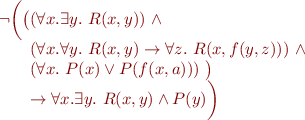Herbrand Model and Unsat Proof for an Example
We will look at the language  where
where
 is relation symbol of arity one
is relation symbol of arity one is relation symbol of arity two
is relation symbol of arity two is a constant
is a constant is a function symbol of two arguments
is a function symbol of two arguments
Consider this formula in  :
:

We are interested in checking the validity of this formula (is it true in all interpretations). We will check the satisfiability of the negation of this formula (does it have a model):

Parsing the formula.
Negation normal form.
Skolem normal form for each clause.
Herbrand universe.
Propositional expansion.
Propositional proof.
Recovering first-order proof from propositional proof.